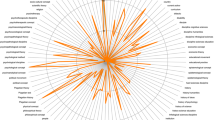Abstract
In 19th-century literature, the character of the anatomist, a new avatar of the demonic hero, embodies a negative conception of science: a figure of limitation rather than of triumph. Though this morbid scientist first appears in gothic and romantic works, his appearance in critical texts confirms what the former suggests: the anatomist carries out a meta-textual function as a metaphor for the author. Thus the question arises: which science does the anatomist’s scalpel serve and, consequently, which writing is served by the writer’s pen?
Similar content being viewed by others
Bibliographie
Balzac, H. de (1830). Le Couteau à papier, Le Voleur, février 1830.
Borel, P. (1985). Don Andrea Vesalius. L’anatomiste. In Steinmetz, J. L. (Ed.), Champavert. Contes immoraux. Paris: Le Chemin vert.
Bernard, C. (1970) Introduction à l’étude de la médecine expérimentale. Paris: Garnier Frères.
Dufour Ph. (1998). Le Réalisme. De Balzac à Proust. Paris: PUF.
Flaubert G. (1954). Bouvard et Pécuchet. Paris: Garnier frères.
Féval P. (1973). Les Mystères de Londres. Genève: Editions de Crémille.
Hadot P. (2004). Le Voile d’Isis. Essai sur l’histoire de l’idée de nature. Paris: Gallimard.
Haynes R. D. (1994). From Faust to Strangelove. Representations of the Scientist in Western Literature. Baltimore & London: The Johns Hopkins University Press.
Hugo V. (1963). Le Dernier Jour d’un condamné. In: Romans. L’intégrale, t. 1. Paris : Seuil.
Janin J. (1973). L’Âne mort et la femme guillotinée (Ed. Bailbé J.-M.). Paris: Flammarion.
Janin J. (1876) De l’influence de la plume de fer en literature. In: Mélanges et variétés, t. 1. Paris: Librairie des bibliophiles.
Janin J. (1830). Journal des Débats, 26 décembre.
Jordanova L. (1989). Images of gender in science and medicine between the eighteenth and twentieth century. New York: Harvester Wheatsheaf.
Lansbury L. (1985). The Old Brown Dog, Women, Workers and Vivisection in Edwardian. England Mafison: University of Wisconsin Press.
Lautréamont (1960). Les Chants de Maldoror (1869–74). Paris: José Corti.
Mandressi R. (2003). Le Regard de l’anatomiste. Dissections et invention du corps en Occident. Paris: Seuil.
Méré Ch. (1995). Le Marquis de Sade. In: Pierron, A. (Ed.), Le Grand Guignol. Le Théâtre des peurs de la Belle Epoque. Paris: Laffont, coll. Bouquins.
Meyer A. (2003). Le Spectacle du secret. Marivaux, Gautier, Barbey d’Aurevilly, Stendhal et Zola. Genève: Droz.
Nodier Ch. (1821), Le Petit Pierre, traduit de l’all, de Spiess. Premier article, Annales de la littérature et des arts, vol. II.
Pichot A. (1832). Une autopsie. Conte anatomique, Revue de Paris, février 1832, 1ère série, vol 35, 201–225.
Pommier A. (1831). La Pile de Volta. Recueil d’anecdotes violentes, publié par un partisan de la litttérature galvanique. Paris: Abel Ledoux.
Richepin J. (1892). Cauchemars. Paris: Charpentier et Fasquelle.
Sade (1975). Les Cent Vingt Journées de Sodome ou l’école du libertinage. Paris: coll. 10/18.
Sade (1897). La Nouvelle Justine ou les malheurs de la vertu. Paris: Jean-Jacques Pauvert.
Sue E. (1888). Les Mystères de Paris. Paris: Charpentier.
Tropp M. (1990). Images of fear. How horror stories helped shape modern culture (1818–1918). Jefferson: Mac Farland.
Zola E. (2002). Mes Haines. Germinie Lacerteux, par Mm. Edmond et Jules de Goncourt (1866). In Mitterand H. (Ed). Œuvres complètes, t. 1: Les débuts (1858–1865). Paris: Nouveau Monde Editions.
Zola E. (2004). Edmond et Jules de Goncourt. In Mourad F.-M. (Ed.) Œuvres complètes, t. 10 : La Critique naturaliste (1881). Paris: Nouveau Monde Editions.
Author information
Authors and Affiliations
Corresponding author
Rights and permissions
About this article
Cite this article
De Mulder, C. L’homme au scalpel: la figure de l’anatomiste dans le roman terrifiant du XIXe siècle. Neophilologus 92, 409–416 (2008). https://doi.org/10.1007/s11061-007-9081-9
Received:
Accepted:
Published:
Issue Date:
DOI: https://doi.org/10.1007/s11061-007-9081-9




